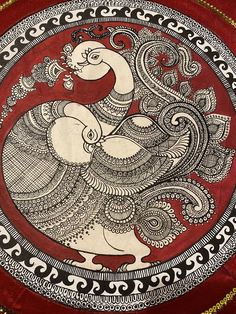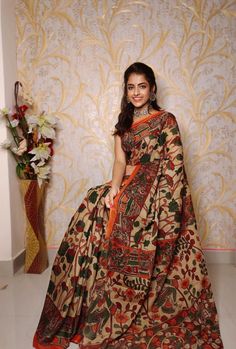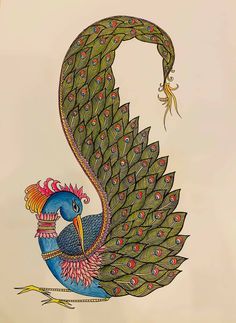Kalamkari Design 05
Kalamkari sarees are a remarkable expression of India’s rich textile heritage, combining intricate artistry with cultural narratives. This traditional craft, rooted in the Indian states of Andhra Pradesh and Telangana, has garnered global appreciation for its vibrant colors, detailed motifs, and storytelling capabilities. Kalamkari, meaning “pen work,” refers to both hand-painting and block-printing techniques that artisans use to create exquisite designs on fabric. This article delves into the history, techniques, themes, and contemporary relevance of Kalamkari saree designs, highlighting their unique charm and significance.
Historical Background
Origins of Kalamkari

Kalamkari art has ancient origins, with references found in texts dating back thousands of years, including the Mahabharata and Ramayana. Historically, this art form flourished under the patronage of temples and royal courts, where artisans created textiles for worship and ceremonial purposes. The craft evolved during the Mughal era, adopting Persian influences and enhancing its complexity.
Cultural Significance
Kalamkari sarees have long been more than just garments; they are cultural artifacts that reflect India’s spiritual and artistic heritage. Traditionally, these sarees depicted scenes from mythology, folklore, and nature, serving as a canvas for storytelling. Each saree tells a story, embodying the values, beliefs, and aesthetics of the community from which it originates.
Characteristics of Kalamkari Sarees
Intricate Designs
One of the defining features of Kalamkari sarees is their intricate designs. The motifs often include depictions of Hindu deities, mythological scenes, floral patterns, and geometric shapes. Artisans painstakingly create these designs, ensuring each piece is a unique work of art.
Vibrant Colors
Kalamkari sarees are known for their vibrant colors, achieved through natural dyes derived from plants and minerals. Common sources include indigo for blue, turmeric for yellow, and pomegranate for red. These natural dyes not only enhance the aesthetic appeal but also ensure that the sarees remain environmentally friendly.
Natural Fabrics
Typically made from cotton or silk, Kalamkari sarees are breathable and comfortable, making them suitable for various occasions. The use of natural fabrics also aligns with the growing trend of sustainable fashion, appealing to environmentally conscious consumers.
Techniques of Kalamkari
Hand-Painting
In hand-painted Kalamkari, artisans use a tamarind stick, sharpened to a point, to draw intricate designs on the fabric. This technique allows for fine detailing and personalization, resulting in unique sarees. The painstaking process can take days or even weeks, depending on the complexity of the design.
Block-Printing
Block-printing is another technique used in Kalamkari, where artisans carve designs into wooden blocks, which are then stamped onto the fabric using natural dyes. This method allows for consistency in patterns and is particularly useful for producing larger quantities of sarees while retaining the integrity of the designs.
Dyeing Process

The dyeing process in Kalamkari is labor-intensive and involves several steps:
- Preparation: Fabrics are treated to ensure colors adhere effectively.
- Dye Extraction: Natural dyes are extracted from plants and minerals, creating a palette of colors.
- Application: Dyes are applied using hand-painting or block-printing techniques.
- Fixing Colors: The dyed fabric is washed and treated to ensure the longevity of the colors.
Themes and Motifs
Mythological Narratives
Kalamkari sarees frequently feature scenes from Hindu mythology. These narratives often portray deities, epic battles, and moral lessons, making each saree a storytelling medium. Wearing a Kalamkari saree can evoke a sense of connection to the rich tapestry of Indian mythology and culture.
Nature and Folklore
Nature plays a significant role in Kalamkari designs, with motifs such as flowers, animals, and celestial elements frequently depicted. These natural elements symbolize fertility, prosperity, and the interconnectedness of life, enhancing the spiritual resonance of the saree.
Geometric Patterns
Geometric designs are also prominent in Kalamkari sarees, providing a sense of balance and rhythm. These patterns often complement the more intricate motifs, creating a harmonious visual experience.
Contemporary Trends
Fusion Fashion
Kalamkari sarees have found a new audience in contemporary fashion. Designers are experimenting with modern silhouettes, draping styles, and cuts while retaining traditional motifs. This fusion of styles appeals to younger generations seeking to express their individuality while honoring cultural heritage.
Sustainable Fashion
As sustainability becomes a focal point in the fashion industry, Kalamkari sarees are increasingly recognized for their eco-friendly attributes. The use of natural dyes and traditional craftsmanship aligns with the values of consumers who prioritize ethical fashion choices. By choosing Kalamkari sarees, wearers support artisanal practices that are both environmentally and culturally sustainable.
Global Appeal
Kalamkari sarees are gaining recognition on international platforms, with designers and fashion enthusiasts around the world embracing their beauty. Exhibitions and fashion shows featuring Kalamkari textiles help promote Indian craftsmanship and provide artisans with new markets for their work.
Challenges Faced by Kalamkari Artisans
Despite the revival of interest in Kalamkari, artisans face several challenges:
Economic Viability
Many Kalamkari artisans struggle to earn a sustainable income due to the labor-intensive nature of the craft. Mass-produced alternatives often overshadow handmade products, making it difficult for artisans to compete.
Preservation of Techniques

As modern production methods gain traction, there is a risk that traditional Kalamkari techniques may be lost. It is essential to document and teach these methods to ensure their continuation for future generations.
Access to Resources
Artisans often encounter difficulties in sourcing quality raw materials, such as natural dyes and fabrics. Improved supply chains and access to resources can significantly enhance their livelihoods and the quality of their work.
Conclusion
Kalamkari sarees are more than just garments; they are wearable art pieces that encapsulate India’s cultural narratives, spirituality, and craftsmanship. The intricate designs, vibrant colors, and rich symbolism make these sarees a unique addition to any wardrobe. As Kalamkari continues to evolve and adapt to contemporary fashion trends, it remains a vital part of India’s textile heritage.
By choosing Kalamkari sarees, wearers not only celebrate traditional artistry but also support sustainable practices and empower artisans. Each saree tells a story, making it a meaningful choice that connects the wearer to the past while embracing the present. In a world increasingly focused on sustainability and authenticity, Kalamkari sarees stand out as a beautiful testament to India’s rich artistic legacy and a reminder of the power of tradition in modern fashion.
